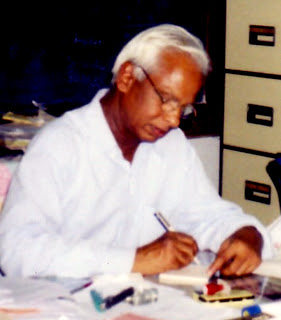Krushna Singh, the king of a
small kingdom in what is today’s Southern Odisha, retold Vyasa’s Mahabharata in Odia, which is popularly
known as “Krushna Singh Mahabharata”, more than two centuries after Sarala had
composed his magnum opus. Noting that the great Sarala had deviated
considerably from the classical narrative, he wanted to give the Odias a feel
of Vyasa’s composition. He began his Mahabharata
with the following observation: one who wants to write Mahabharata, must first
pay one’s obeisance to Narayana, then to Nara, after that to goddess Saraswati
and then to the poet Vyasa, and then start narrating the story of jaya (victory). This could be viewed as
his disapproval of what Sarala had done. Sarala had chosen to commit an act of
almost sacrilege; he had set aside a traditional ritual. Singh did not mention
Sarala by name, but it is very obvious that it was he who he had in mind.
Sarala had made no mention of any of the above-mentioned – Narayana, Nara, etc.
- in his invocation (which, incidentally, one would think a bit too long for an
invocation); he had substituted them with god Ganesha and goddess Sarala.
By then Ganesha must have come to
be accepted in Odisha as vighnaraja
(the remover of obstacles), who must be given the first worship; so he offered
prayers to him first as part of his invocation and then he prayed to Sarala, his
village deity, whose staunch devotee he was and of who he would say more than
once in his Mahabharata that she was
the real composer of the narrative. He only wrote what she composed. This is
reminiscent of Vyasa dictating the slokas
(couplets) of his Mahabharata to
Ganesha and Ganesha writing them down. But here the scribe was the devotee and the
composer, the object of his devotion. By mentioning goddess Sarala in his
invocation, as he set aside the tradition, the poet Sarala foregrounded the
personal and the local.
Could his invocation be also seen
as his message for his audience that he was going to take liberties with the
classical narrative? Thus for Sarala, the celebrated sage, Vyasa, was a character
in the story; the one who created the Mahabharata narrative was the seer
Agastya (Agasti). The seer told the story to Baibasuta Manu. Many, many hundred years
later, Sarala was telling this story to his audience.

No comments:
Post a Comment